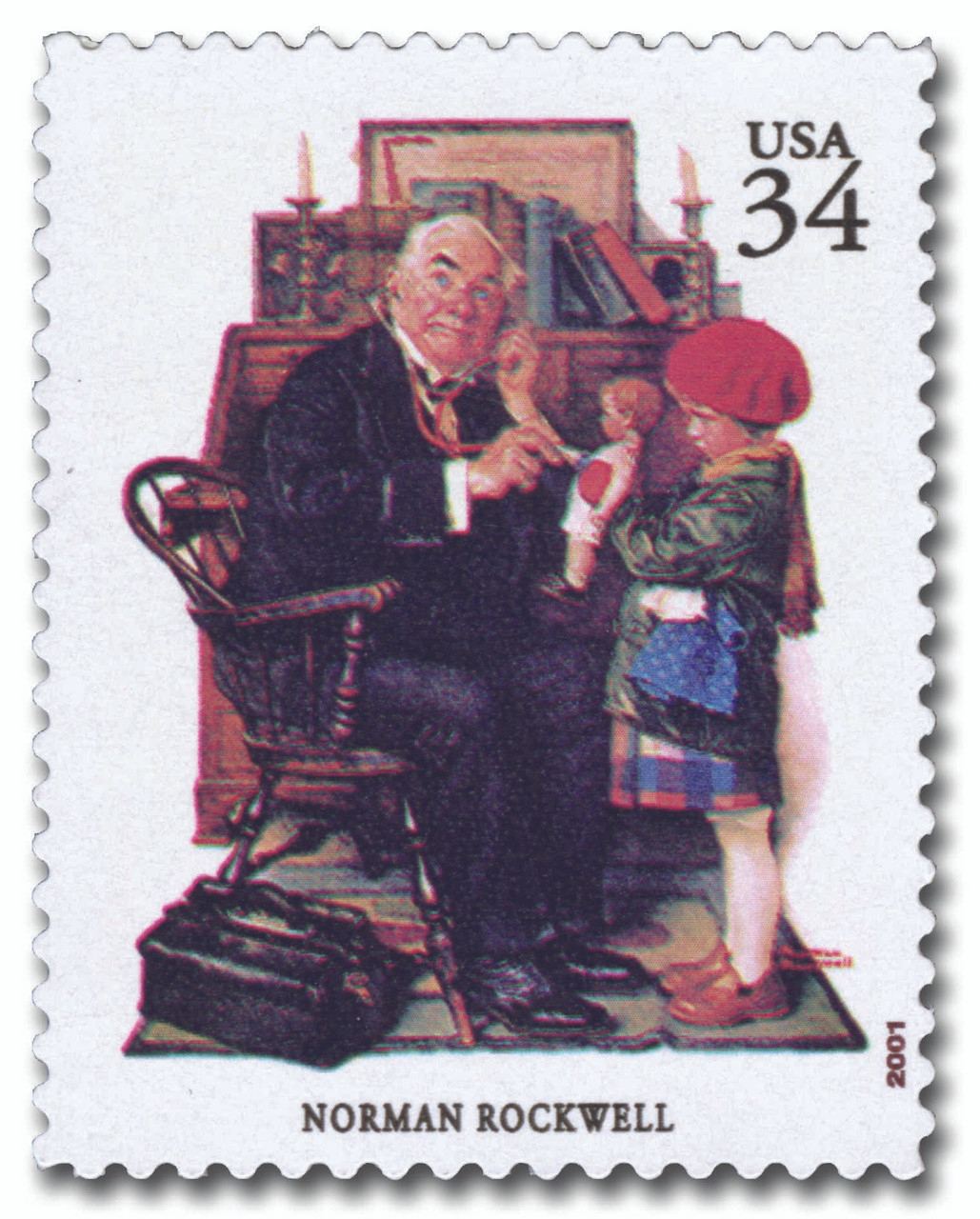
U.S. #3502s
Norman Rockwell
34¢ American Illustrators
Issue Date: February 1, 2001
City: New York, NY
Quantity: 125,000,000
Printed by: Avery Dennison Security Printing
Printing Method: Photogravure
Perforations: Serpentine die cut 11.25
Color: Multicolored
This set of stamps from the Cl... more
U.S. #3502s
Norman Rockwell
34¢ American Illustrators
Issue Date: February 1, 2001
City: New York, NY
Quantity: 125,000,000
Printed by: Avery Dennison Security Printing
Printing Method: Photogravure
Perforations: Serpentine die cut 11.25
Color: Multicolored
This set of stamps from the Classic Collection Series showcases the art of twenty American illustrators of magazines, posters, books, and advertisements. The Saturday Evening Post cover, is by Norman Rockwell. Rockwell painted ordinary people, with humor and compassion, in magazines, calendars, and advertisements.
The Saturday Evening Post
On August 4, 1821, The Saturday Evening Post published its first issue.
According to the Post’s official history, it has a neat connection to Benjamin Franklin! In 1728, Franklin had the idea to create The Pennsylvania Gazette magazine. However, before he had a chance to begin work on the paper, his partner, Samuel Keimer, stole the name and idea. Luckily for Franklin, the paper failed within a year, and he and Hugh Meredith took over production in 1729.
Under Franklin’s leadership, the Gazette became one of the most influential newspapers in the American colonies. By 1748, he had experienced enough success with his various business ventures to retire. The Gazette continued on without him until 1800, but Franklin’s print shop where it was produced remained open.
Twenty years later, Samuel Atkinson was running the shop when Charles Alexander submitted an idea. He wanted to print a popular poem about a blind girl in the city who set type by hand. The poem was so popular, he managed to find 200 people who would subscribe to the poem. Based on that interest, he suggested to Atkinson that they start a newspaper.
Atkinson and Alexander decided to name the new paper The Saturday Evening Post because it would be printed and ready for the second mail delivery on Saturdays. The first issue was produced on August 4, 1821. The Post included local and national news, including the letters between former presidents John Adams and Thomas Jefferson. And while the paper was printed on Franklin’s press, much of the writing also matched his style. Subjects included business, law, exploration, fashion, etiquette, agriculture, and science.
Over the years, the Post featured the works of many renowned authors, including Edgar Allen Poe, James Fenimore Cooper, Harriet Beecher Stowe, Washington Irving, and Mark Twain. But by the late 1890s, the paper had become watered down with trivia and fashion news and didn’t feature any illustrations or advertising. It dropped to only about 2,000 readers.
Following the death of the Post’s owner in 1899, the editor turned to Cyrus Curtis. Curtis had founded the Ladies’ Home Journal (the first American magazine to reach a circulation of one million) and wanted to try to save the historic Post. He started using the profits from the Ladies’ Home Journal to fund his improvements to the Post. Curtis introduced new content, redesigned the pages, and printed full-cover illustrations. While some of the current subscribers didn’t like the new direction, others did, and by 1900, he had 250,000 readers. By 1908, he had over one million readers and had invested $1,250,000 in the Post.
Curtis was also one of the first publishers to realize that advertising, rather than the price paid by customers, was the future in funding the paper. He was diligent in only including wholesome, honest advertisements from reputable ad agencies, which earned the loyalty of his readers.
Curtis’ editor, George Lorimer, was also influential in the Post’s success. He worked hard to make the Post appeal to people all over the country, while most publications of the day were more regional. Lorimer also sought out the day’s best writers and paid them faster than other publications, which in turn encouraged them to go to the Post first. He attracted such writers as Joseph Conrad, O. Henry, Rudyard Kipling, and Jack London. He also convinced former president Grover Cleveland to write a series of articles.
Lorimer is also credited for the Post’s famous colorful covers. He personally picked the covers, which became one of the most talked-about aspects of the magazine. Over the years, the Post featured covers by Andrew Wyeth, JC Leyendecker, and George Hughes. Of course, the most famous cover artist was Norman Rockwell, who worked on his first Post cover in 1916 and would produce a total of 321 covers during his 47-year relationship with the publication.
By 1960, the Post reached its peak circulation of 6 million readers. However, the rise in popularity of television and an increased number of magazines provided lots of competition. Readership declined and the Post closed in 1969. It was revived in 1971 as a quarterly publication and is still in publication today.
Click here to view lots of historic Saturday Evening Post covers.

















